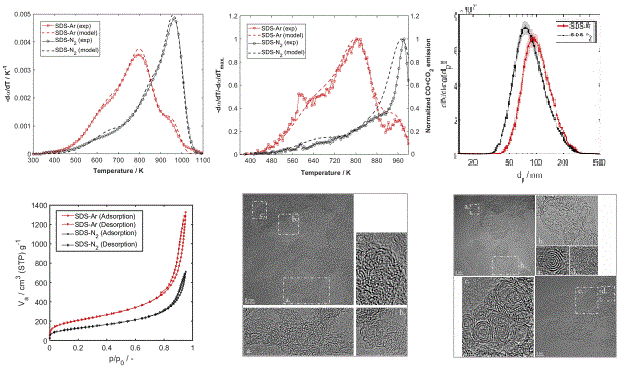Hagen FP, Rinkenburger A, Gunther J, Bockhorn H, Niessner R, Suntz R, Loukou A, Trimis D, Haisch C
Journal of Aerosol Science (2020)
Abstract
Spark discharge generators enable a fast, reliable, continuous, and highly reproducible production of nanoparticle aerosols along with a widely tunable size distribution. Graphite spark discharge generators have been particularly applied for studies of instrument calibration, filter testing, soot reactivity studies, and in toxicological risk evaluation of soot. Until now, it has been consensus that soot produced in spark discharge generators is highly reactive because of its high surface area and its amorphous nanostructure. In this paper, we will demonstrate that the properties of soot produced in spark discharge generators strongly depend on the used carrier gas (i.e. argon, nitrogen). Soot produced in argon (spark discharge argon soot, SDS-Ar) as carrier gas is composed of a major fraction with high reactivity exhibiting a temperature at maximum oxidation rate Tmax between 796 K and 803 K. Soot produced in nitrogen (spark discharge nitrogen soot, SDS-N2) has a similar size distribution as SDS-Ar, whereas the main fraction is less reactive (963 K < Tmax < 983 K). This can be derived from temperature programmed oxidation (TPO) and thermogravimetric analysis (TGA) and also correlates well with a considerable higher BET surface area of SDS-Ar (679 m2 g−1) compared with SDS-N2 (426 m2 g−1). C/H/N Elemental Analysis, High-Resolution Transmission Electron Microscopy (HRTEM), Raman- and FTIR-spectroscopy complement the measurements, all leading to the observation that SDS-N2 has a more graphitic nanostructure than the highly amorphous nanostructure of SDS-Ar (Raman spectra SDS-Ar: I(D, disordered bands)/I(G, graphite band) = 0.76, SDS-N2: I(D)/I(G) = 1.0 or elemental analysis SDS-Ar: H/C = 0.25, SDS-N2: H/C = 0.10). These findings imply that studies applying spark discharge soot have to be critically viewed with respect to the used carrier gas. Spark-over field strength, Paschen's law, the energy release within the arc, decaying plasma or cooling rates, as well as dissociation/ionization processes are discussed to explain the observations above. Finally, we want to emphasize that it is possible to vary the reactivity towards oxidation and nanostructure of spark discharge soot simply by applying different mixtures of the carrier gas.
